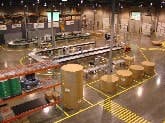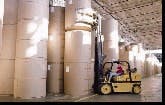Recent mandates by DOD and Wal-Mart are making many manufacturers see radio frequency identification (RFID) as an onerous additional cost of doing business. But the technology offers potential benefits far beyond satisfying the demands of supply-chain gorillas.
RFIDs strengths include non-line-of-sight reading, multiple reads at long ranges and high speeds, potential for higher security, the ability to change and add information, and reliable performance in harsh environments. Radio-based systems promise more flexible and efficient warehouse management; raw material and work-in-progress (WIP) tracking and control; maintenance stores and tool tracking; and asset identification, location and condition-monitoring capabilities.
2. Explain it to operations and describe the options.
3. Identify problems for application.
4. Do a pilot, collect the data, calculate ROI.
5. Decide whether and where to roll out.Costs are coming down rapidly, and emerging standards offer some assurance that the system you chose today will support your expanding needs. Instead of just paying to play among DOD and Wal-Mart suppliers by hastily pasting RFID labels on outgoing products, forward-thinking plants are planning implementations with an eye to solid ROI.You can slap and ship, or you can have a vision, says Carolyn Lankford, IT architect, Cummins Power Care, Memphis, Tenn. Start with the right first impression so you can get on board with the right vision and strategy. You want to build a foundation for growth, not a series of limited, expensive, one-off solutions.
Streamline warehouse management
Even though youre being hit with a compliance mandate, if you dont integrate it into your process, youre just adding cost, says Matt Ream, senior manager of RFID systems, Zebra Technologies (www.zebra.com). Once you put in infrastructure for compliance, you can use it for yourself, for incoming goods, work in process, and so on.
Your RFID initiative will almost certainly start with storage and retrieval of raw materials, WIP or finished products. That was the case at International Papers bleached board mill in Texarkana, Texas, where large rolls of paper are stocked and shipped in a 375,000-square-foot warehouse and distribution facility.
We want to know where every roll of paper is in our facility, says Don Forst, manager of operational services at the mill. A lost roll can cost thousands of dollars. We wanted real-time knowledge, not information about our inventory every three to six months. By knowing that, we can serve customers better and manage waste.
The plants investigation and requirements for RFID technology led to the development of International Papers Customer Solutions Center in Memphis, Tenn., as part of the companys Smart Packaging group (www.ipsmartpackaging.com). The center (Figure 1), which opened for business in June 2004, includes a non-temperature controlled warehouse, complete with concrete floors and walls, metal racking and a host of industrial equipment to provide a real-world warehouse environment. It adds up to a fully integrated warehouse demonstration, testing and training facility.
On a roll
At Texarkana, product is made to order. Roll cores are identified with passive smart-label tags that associate it with order data throughout manufacturing, storage and shipping. The mill facility and yard are huge, and paper rolls have shelf-life issues. Humidity, dust and debris can cause degradation, so location tracking is critical.
Hardware and software are predominately clamp-truck-mounted, creating mobile reader stations. The warehouse tracking software is fully integrated with the plants legacy MES system and an 802.11b network that supports the truck-mounted terminals. The system can track inventory to within six inches using passive RFID tags with a minimum of stationary readers.
The system takes advantage of RFIDs at-a-distance capabilities. You can keep track all the time, says Scott Medford, vice president, RFID, Intermec (www.intermec.com). Its very good in a chaotic environment. You have freedom of movement, you can put things away in any open slot. You dont have to have a preset allocation scheme.
At International Papers Texarkana, Texas plant, clamp truck terminals give operators routing instructions and detect roll placement, making it easy to change the warehouse configuration.When the rolls enter the warehouse, the clamp truck terminal gives the operator routing instructions -- the operator performs no manual scan/read at pickup or set-down (Figure 2). If a placement or movement error occurs, the system will prompt with emergency requests. This approach makes it easy to change the warehouse configuration without hardware changes.RFID puts a wealth of information at your fingertips, says Ashmore. The system gives us product flow patterns in the warehouse and on conveyors, docks and upenders. We get to the next level of efficiency by adjusting the warehouse layout and flow.Its also accurate. The tags are more durable than bar-code labels, and automatic scanning minimizes missed scans. A lot of people would like to be doing more bar-coding, says David Douglas, executive vice president, products, at software company ConnecTerra (www.connecterra.com). They want to read more often but cant afford the time. RFID can free people from dealing with line-of-sight issues.The system knows exactly where the clamp trucks and rolls are at all times, information that Texarkana says has improved inventory accuracy and eliminated lost product, as well as reduced operating costs and decreased inventory levels.People tend to focus on the sexy wireless part of it, but the value is in the granularity of the data, says Douglas. How long is each thing spending in the warehouse? Is some material going bad in there?Comprehensive location tracking can raise questions from operators who may have concerns about how youll use the data on their activities. You have to be open and honest and make sure everyone understands the capabilities, says Ashmore. If you dont do that, the gray area will be a problem. Give all employees the same information. An engaged workforce can see the value of the efficiencies.
Get a grip on WIP
The capabilities that let RFID revolutionize warehouses can be harnessed to improve flow, quality and yield of WIP. The same tag technology can be used to track raw materials, WIP and assets, says Douglas. One set of software can sit at the edge, divide up the data depending on what it is and who is interested, and route the information to the appropriate system.
While consumer packaged goods (CPG) manufacturers are turning to RFID for logistics by mandate, other manufacturers have been using closed systems for years for internal purposes. These are coming together, says Medford.
Raw material tags can provide information to batch control systems to vary quantities and processing parameters. Production tooling with RFID tags can give machine tools setup information such as clamping force or drilling speed.
For example, an engine block casting that may become any one of several engine models can be tagged and the RFID information used to determine the settings on CNC machines, torque wrenches, etc.
If youre machining an engine block and the machine goes down, you set it aside and repair the machine, Medford says. But whats the status of that block? With RFID, you can know, and you can salvage it. This has given tremendous savings.
The same tag can be used to track forward through the product life and backward to the original casting. As the engine goes into another plant for assembly, they know immediately which engine it is, how many they have, where they are, and their status -- they can route them directly from the dock to production.
Tags shipped with product can monitor, record and broadcast parameters like shock, moisture, vibration and temperature in transit, or even in production. Another interesting application is concrete curing, says Ream. An active tag with temperature recording capability can be dropped into the pour, and the resulting temperature profile gives evidence that the concrete has cured properly.
The mind starts to boggle. I like to look at the tag as a hard drive, says Alex Stuebler, business manager, factory automation sensors, Siemens (www.siemens.com). You dont need a cable, just an EM field -- and you can write to the tag. You can record temperature of the AC unit in a trailer, power conditions, etc., and write them to RFID.
In two to three years, new sensing technologies coming from wireless sensors and mesh networks will interact with RFID infrastructures. Once you have the infrastructure, you can imagine what you can do with it, Stuebler says. Warehouses today have closed-loop applications. They are developing so they can take the materials coming in and add information for the next step, which adds efficiencies to the whole supply chain. In the future, tag systems will be universal and have more capabilities.
Track tools and spares Right now, RFID is being used in maintenance applications to track spare parts, materials and tools. Along with the aforementioned improvements in accuracy and automation of real-time inventories, using RFID tends to help keep things where they belong.
Automatic check-out and check-in of tools and materials helps make sure things dont leave on their own, says Ream. It gives you visibility into holes in your operations, and allows rapid physical inventory with a hand-held scanner. Smart-shelf technology knows when something leaves a shelf if it isnt checked out in a reasonable time, it can send a message.
The aerospace industry is going one step further. Plant maintenance applications include tool tracking, especially power and air tools, leased tools and tools that require repairs or calibration, says Medford. Tagging tends to keep tools from being lost or left inside the work.
A misplaced tool can end up going to Timbuktu or worse, through a turbine, so repaired aircraft are not allowed to leave until all tools are returned. RFID expedites the process, which is nice if yours is the delayed flight.
Writeable tags on spare and rebuilt components can store information about the parts history, such as how many hours it has on it and when it was last rebuilt. The same approach expedites control of tools (e.g. calibrators) that must be certified at regular intervals for regulatory compliance.
Accurate, real-time inventories are increasingly interesting to the government, Medford says. RFID helps support Sarbanes-Oxley by answering the question, What assets do I own?
Truck 54, where are you?
Another RFID frontier is tracking the locations and conditions of assets to improve uptime and streamline maintenance activities. Mobile asset-intensive facilities have been saving money for some time with these capabilities, and their ROI proffers a path to profit for mandate-driven initiatives.
Companies are spending millions to comply with directives by Wal-Mart and the Department of Defense, but the jury is out on money- or cost-savings, says Greg Smith, vice president, marketing, I.D. Systems (www.id-systems.com). The retailer or buyer gets the benefits. Suppliers hope for fewer stock outages and higher sales, but thats just a carrot, he says, Vehicle management is already a proven money-maker.
Returns are highest for fleet operators, but can still be significant anywhere you have a collection of lift trucks or similar equipment. Smith cites the example of a major CPG manufacturer where maintenance teams were scored and bonused on preventive maintenance (PM) activities per month.
Maintenance had trouble getting the newer fork lifts in for PM because the operators preferred them and would not stop running them, in fact, they would hide them in obscure areas at the end of their shifts so they could have them again the next day. The maintenance techs wanted their bonuses, so they were wasting time hiking around the plant looking for fork lifts to work on. They did PMs on the machines they could find, which were the older ones. This resulted in the older machines getting PMs every 80-100 hours while new machines were averaging some 400 hours between PMs.
The plant installed an I.D. Systems Wireless Asset Net that tells where each forklift is located and how it is used. It also restricts vehicle access to authorized operators, reports vehicle problems in real time, and allows maintenance to be scheduled according to actual vehicle usage rather than on a calendar basis.
Our system uses GPS outdoors and a radio-based location system indoors, says Smith. It can read tags on whats on the forks or in tow, and on what its going by, and send location information from the vehicle instead of wiring the whole area. The system can notify the operator of needed service, alarm, and if necessary, immobilize the vehicle so that it will run only for a maintenance technician.
RFID will merge with vehicle management someday -- its a logical progression that offers some very interesting efficiencies, Smith says. But vehicle systems are generating return now.
An RFID-based forklift monitoring system from Shockwatch (www.shockwatch.com) monitors voltage to extend battery life and reduce electric lift truck motor, relay contact and SCR control failures. The company says running batteries at an optimum charge level also aids forklift truck productivity because of faster travel and hoisting speeds. The system also can control driver access and monitor impact events during lift truck operation.
International Papers truck-mounted system tells Texarkana plant technicians when its in trouble. The vehicles troubleshoot themselves, says Jim McFee, maintenance manager. They let us know when maintenance is needed by giving us messages like, This truck has this problem with this antenna. This helps us know what maintenance issues to address and when, improving the productivity of our fleet.
Avoid RFID blues
RFID equipment is not a lot different from other electronic and software-based systems. If its properly engineered, your technicians can probably handle it. The RFID system requires very little maintenance, says McFee. Its an integrated system, and presents no challenge to our competent instrument electricians. The readers are reliable and accurate.
|
Sato America has published an excellent white paper that covers RFID basics including active versus passive, read-only versus read/write, the various frequencies and standardization. The SATO RFID white paper may be found at http://satoamerica.com/rfid_gt_rqst.asp?frmID=rfid Zebra posts resources ranging from Zebras RFID Readiness Guide: Complying With RFID Tagging Mandates to Increasing Profits and Productivity: Accurate Asset Tracking and Management With Bar Coding and RFID. The latter includes worksheets to help calculate ROI. See www.zebra.com/id/zebra/na/en/index/resource_ GlobeRanger offers a number of white papers full of ideas and examples of companies improving profits through compliance at www.globeranger.com/csawp.php |
| Cummins Power Care supplies the companys aftermarket needs from components to complete remanufactured diesel engines. As a Department of Defense supplier, its distribution center has a deadline of January, 2007, for compliance with RFID mandates. IT Architect Carolyn Lankford is leading the technology integration effort. As a first step, I researched the Internet, says Lankford. Theres a lot of positive information, but theres also a lot of paranoia, inaccuracy and negative press. Before we spend money, we want solid information. The technology, though not new, is commercially new, Lankford says. The way to introduce it to business and IT personnel is through training. She and 14 other Cummins IT and business people attended a one-day class at International Papers Customer Solution Center in Memphis. Its a very well-executed class, very granular, she says. The class included a detailed tour of the center, an overview of example applications, and a session where they talked as a group about RFID at Cummins. Lankford says, It gave us a common knowledge base so when we got back to our desks, we were able to speak intelligently. Lankford followed up with a half-day class for another group including site business, IT and operations leaders. Their challenging questions were immediately answered and we came away with a very good understanding, she says. It was the view the executives needed, with examples that inspire vision. Cummins is continuing to participate in think-tank and brainstorming activities to refine its RFID plans. By this fall we will be able to define our project, Lankford says, then well pilot, implement, and be in compliance on time. |


